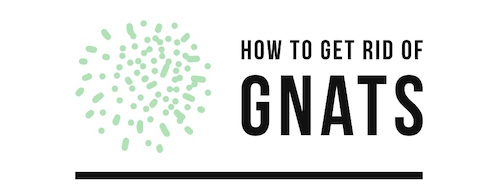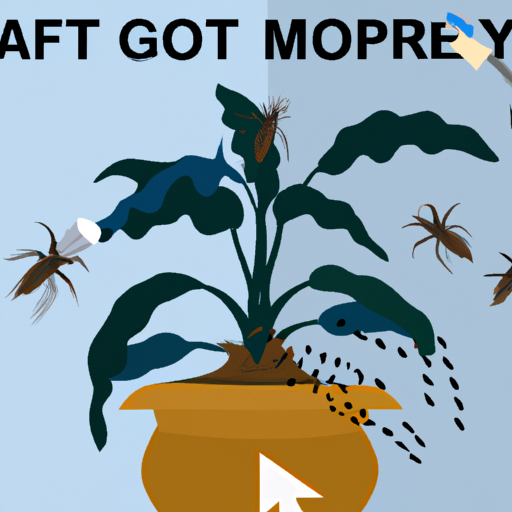How to Identify Gnats in Houseplants
Gnats in houseplants can be a nuisance and can cause damage to the plants. Identifying gnats is the first step in controlling them.
Gnats are small, flying insects that are usually black or dark brown in color. They have long legs and antennae, and their wings are held outstretched when they fly. Gnats may also be mistaken for fruit flies, but they are smaller than fruit flies and do not have red eyes like fruit flies do.
The most common type of gnat found in houseplants is the fungus gnat (Sciaridae). Fungus gnats feed on decaying organic matter such as plant roots, fungi, algae, and other plant debris. They lay their eggs near these sources of food so that when the larvae hatch they will have a ready source of food available to them.
To identify fungus gnats in your houseplants look for small black or dark brown flying insects hovering around your plants or resting on leaves or stems. You may also see larvae crawling around on the soil surface or near plant roots; these larvae look like tiny white worms with black heads. If you suspect you have an infestation of fungus gnats it is important to take action quickly as they can cause significant damage to your plants if left unchecked.
Natural Ways to Get Rid of Gnats in Houseplants
Gnats are a common problem in houseplants, but there are several natural ways to get rid of them. Here are some tips for getting rid of gnats in your houseplants:
1. Remove any dead or decaying leaves and stems from the plant. This will help reduce the number of gnats that may be living on the plant.
2. Place yellow sticky traps near the plants to catch adult gnats as they fly around looking for food and water sources.
3. Make a homemade insecticidal soap by mixing one tablespoon of dish soap with one quart of warm water and spraying it directly onto the affected plants every few days until you no longer see any signs of gnat activity.
4. Use neem oil, an organic pesticide derived from neem trees, to kill off adult gnats and their larvae on contact without harming beneficial insects like bees or ladybugs that may also be present in your home garden or greenhouse environment.
5. Introduce predatory insects such as green lacewings or parasitic nematodes into your home garden or greenhouse environment to help control populations of pests like fungus gnats naturally over time without using harsh chemicals that can harm beneficial insects and other wildlife in your area as well as yourself if inhaled or ingested accidentally during application processes .
The Benefits of Using Insecticides to Control Gnats in Houseplants
Insecticides are a common and effective way to control gnats in houseplants. Gnats, also known as fungus gnats, are small flying insects that feed on the roots of plants and can cause significant damage if left unchecked. Insecticides provide an effective solution for controlling these pests by killing them directly or disrupting their life cycle.
The use of insecticides to control gnats in houseplants has several benefits. First, insecticides can be used to target specific species of gnat, allowing for more precise control than other methods such as physical removal or natural predators. Second, insecticides are generally easy to apply and require minimal effort from the user. Third, they can be used both indoors and outdoors with minimal risk of harm to humans or other animals when applied correctly according to the instructions on the label. Finally, insecticide treatments often provide long-term protection against future infestations by preventing eggs from hatching into larvae that could later become adult gnats.
Insecticide treatments should always be applied carefully according to the instructions on the label in order to ensure safety and effectiveness. It is important not only to follow all safety precautions but also to select an appropriate product for your particular situation; some products may not be suitable for certain types of plants or environments due to their toxicity levels or other factors such as temperature sensitivity. Additionally, it is important not only treat existing infestations but also take preventative measures such as removing standing water sources where possible in order reduce future outbreaks of gnats in your houseplants
How to Prevent Future Infestations of Gnats in Houseplants
Gnats are a common problem in houseplants, but there are steps you can take to prevent future infestations.
First, inspect any new plants before bringing them into your home. Look for signs of gnats or other pests on the leaves and soil. If you notice any, discard the plant and purchase a new one from a different source.
Second, keep your houseplants clean by removing dead leaves and debris from the soil surface regularly. This will help reduce the number of places where gnats can lay their eggs.
Third, water your plants only when necessary and avoid overwatering them as this can create an ideal environment for gnat larvae to thrive in moist soil. Allow the top inch of soil to dry out between waterings and use well-draining potting mix that won’t retain too much moisture.
Fourth, use sticky traps or yellow sticky cards near your plants to catch adult gnats before they have a chance to lay eggs in the soil. Place these traps near windowsills or other areas where light is present as this is where adult gnats tend to congregate most often.
Finally, if all else fails you may need to treat your plants with an insecticide specifically designed for controlling indoor pests such as fungus gnats or root mealybugs (which also attract gnats). Be sure to follow all instructions carefully when using any type of pesticide product indoors as some may be toxic if inhaled or ingested by humans or pets living in the home environment.
Tips for Keeping Your Home Free from Gnat Infestations
1. Keep your home clean and free of food debris: Gnats are attracted to food sources, so it is important to keep your home clean and free of any food debris. Vacuum regularly, wipe down countertops and other surfaces, and make sure that all spills are cleaned up immediately.
2. Store food properly: Make sure that all food items are stored in airtight containers or the refrigerator to prevent gnats from being attracted to them. Also, avoid leaving open containers of fruit or vegetables out on the countertop as this can attract gnats as well.
3. Seal cracks and crevices: Gnats can enter your home through small cracks or crevices in windowsills, door frames, or other areas around the house. To prevent this from happening, seal any cracks or crevices with caulk or weatherstripping material to keep them out of your home.
4. Use natural repellents: There are a variety of natural repellents available that can help keep gnats away from your home such as essential oils like lavender oil or citronella oil which can be sprayed around windowsills and door frames where they may enter the house from outside sources.
5. Use traps: Traps such as sticky fly strips can be used to catch gnats before they become a problem in your home by trapping them on their way inside before they have a chance to reproduce inside the house itself .
Common Mistakes People Make When Trying To Get Rid Of Gnats In Houseplants
1. Not Identifying the Source of the Gnats: Before attempting to get rid of gnats in houseplants, it is important to identify the source of the infestation. Gnats can be attracted to decaying organic matter, such as old soil or plant debris, and this should be removed from around the plant before any other steps are taken.
2. Overwatering Houseplants: Overwatering houseplants can create an ideal environment for gnat larvae to thrive in, so it is important to ensure that plants are not overwatered and that excess water is allowed to drain away properly.
3. Not Cleaning Plant Pots Regularly: Plant pots should be cleaned regularly with a mild soap solution or rubbing alcohol in order to remove any organic matter which may attract gnats and provide them with a food source.
4. Not Using Insecticides Properly: If insecticides are used as part of an effort to get rid of gnats in houseplants, they must be used according to manufacturer instructions and safety precautions must always be followed when using these products indoors.
5. Not Taking Preventative Measures: Once an infestation has been eliminated, preventative measures should be taken in order to reduce the chances of another infestation occurring again in future; this includes regular cleaning and inspection of plants for signs of pests or disease as well as ensuring that plants are not overwatered or kept too wet for extended periods of time
The Best Practices for Controlling and Eliminating Gnat Populations In Your Home
Gnats are small, pesky insects that can be a nuisance in the home. They are attracted to moist areas and feed on decaying organic matter, such as food scraps and plant debris. While they do not cause any serious damage to your home, they can be an annoyance. Fortunately, there are several best practices you can use to control and eliminate gnat populations in your home.
The first step is to identify the source of the infestation. Gnats typically breed in damp soil or other moist areas around the house, such as near drains or potted plants. Once you have identified where they are breeding, it is important to take steps to reduce moisture levels in these areas by improving ventilation and drainage or removing standing water sources.
Next, it is important to remove any potential food sources for gnats from your home environment. This includes cleaning up spills quickly and disposing of food waste properly so that it does not attract gnats into your living space. Additionally, make sure all fruits and vegetables stored at room temperature are kept covered so that gnats cannot access them easily.
Finally, you may want to consider using chemical treatments or traps if necessary for more severe infestations of gnats in your home environment. Chemical treatments should only be used as a last resort after all other methods have been exhausted due to their potential toxicity levels when used incorrectly or excessively indoors; however they can be effective at eliminating large populations of gnats quickly if used correctly according to manufacturer instructions . Traps may also be useful for controlling smaller populations of gnats; however these should also only be used after other methods have been attempted first since traps will not eliminate existing populations but rather just reduce their numbers over time .
Overall , following these best practices will help you control and eliminate any existing population of gnats in your home environment while preventing future infestations from occurring .
Q&A
1. What is the best way to get rid of gnats in houseplants?
The best way to get rid of gnats in houseplants is to remove any decaying organic matter from the soil, such as dead leaves or stems. You can also use a natural insecticide such as neem oil or pyrethrin-based products to kill adult gnats and larvae. Finally, you can introduce beneficial nematodes into the soil which will feed on the larvae and help keep them under control.

